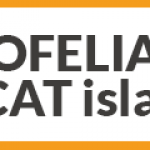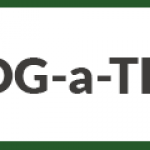What is NITOS?
NITOS facility is comprised of 2 wireless testbeds for experimentation with heterogeneous technologies. An outdoor testbed, featuring Wi-Fi, WiMAX and LTE support and an indoor isolated testbed comprised of advanced powerful nodes. The NITOS testbed is designed to achieve reproducibility of experimentation, while also supporting evaluation of protocols and applications in real-world settings.
The control and management of the testbed are done using the cOntrol and Management Framework (OMF) open-source software. Users can perform their experiments by reserving slices (nodes, frequency spectrum) of the testbed through NITOS scheduler that together with OMF management framework, support ease of use for experimentation and code development.
The NITOS platform is open to any researchers who would like to test their protocols in a real-life wireless network. They are given the opportunity to implement their protocols and study their behaviour in a custom tailor-made environment. NITLab is constantly in the process of extending its Testbed capabilities.
Architecture
The main experimental components of NITOS are:
- A wireless experimentation testbed, which consists of powerful nodes (some of them mobile), that feature multiple wireless interfaces and allow for experimentation with heterogeneous (WiFi, Bluetooth, ZigBee) wireless technologies. NITOS has been extended to a mesoscale testbed, by acquiring WiMAX and LTE Base Stations and by also enabling WiMAX/LTE connectivity to the wireless nodes.
- A Software-Defined Radio (SDR) testbed that consists of Universal Software Radio Peripheral (USRP) devices attached to the NITOS wireless nodes. USRPs allow the researcher to program a number of physical layer features (e.g. modulation), thereby enabling dedicated PHY layer or cross-layer research.
- A Software-Defined Networking (SDN) testbed that consists of multiple OpenFlow technology-enabled switches, connected to the NITOS nodes, thus enabling experimentation with switching and routing networking protocols. Experimentation using the OpenFlow technology can be combined with the wireless networking one, hence enabling the construction of more heterogeneous experimental scenarios.
- A testbed for conducting video-transmission (wired or wireless) related experimentation, which consists of high definition digital cameras, mounted on the NITOS nodes. This component can be combined with the wired (OpenFlow) and wireless testbeds mentioned above, enabling the study of video transmission over heterogeneous communication technologies.
A brief description of each testbed follows, as well as detailed descriptions of several key components they use.
NITOS outdoor testbed
NITOS outdoor testbed consists of powerful nodes that feature multiple wireless interfaces and allow for experimentation with heterogeneous (Wi-Fi, WiMAX, LTE) wireless technologies. It is deployed at the exterior of the University of Thessaly (UTH) campus building, as illustrated in Figure 1.
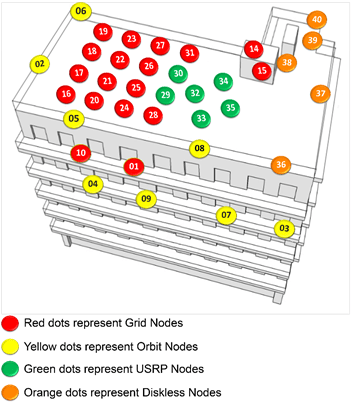 Figure 1: Outdoor Testbed Topology |
 Figure 2: Outdoor Testbed Deployment |
NITOS indoor testbed
The relatively new NITOS indoor testbed consists of 40 Icarus nodes and is deployed in an RF isolated environment in the premises of University of Thessaly’s campus. This testbed is federated with the outdoor one, thus enabling the execution and evaluation of power demanding processing algorithms and protocols in a large scale testbed.

Figure 3: Indoor Testbed Deployment
Icarus Nodes

Figure 4: Icarus Node
Icarus Nodes have been developed by UTH and are equipped with 802.11a/b/g/n wireless interfaces. They feature new generation Intel 4-core CPUs and new generation solid-state drives. More details about their specifications can be found in Table 1.
Table 1: Icarus nodes specifications.
Table 1: Icarus nodes specifications
| NITOS testbeds: Icarus nodes | ||
|---|---|---|
| Motherboard | Features 2 Gigabit network interfaces and supports 2 wireless interfaces | |
| CPU | Intel Core i7-2600 Processor, 8M Cache at 3.40Ghz | |
| RAM | 4G HYPERX BLU DDR3 | |
| Wireless interfaces | Atheros 802/11 a/b/g & Atheros 802.11 a/b/g/n (MIMO) | |
| Chassis Manager Card | UTH’s CM card | |
| Storage | Solid state drive | |
| Power supply | 350 Watt mini-ATX | |
| Antennas | Multi-band 5dbi, operates both on 2,4Ghz & 5Ghz | |
| Pigtails | High quality pigtails (UFL to RP-SMA) | |
SDN Capabilities
NITOS testbeds, both the outdoor and the indoor, operate OpenFlow switches that are connected to the nodes of the testbeds. The user of the NITOS facility is able to reserve nodes for his slice (through the NITOS scheduler) and run an OpenFlow experiment with use of this slice. In particular, the testbed provides transparently an abstract OpenFlow switch for his slice that conceptually is equivalent to a physical OpenFlow switch that includes only the ports of the nodes that he has reserved.
Software Defines Radios
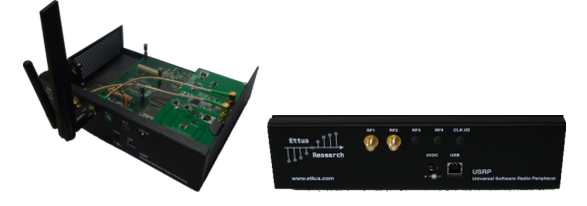
Figure 5: USRP1 Device
NITOS has enhanced a subpart of the NITOS outdoor testbed by adding software defined radio (SDR) capable devices. The platform currently used is based on 10 Universal Software Radio Peripheral (USRP) devices attached either on the NITOS node’s USB or Ethernet interfaces (NITOS has equipped the SDR testbed with 6 USRP1 and 4 USRP N210 devices, placed in such way to cover as much area as possible of the wireless testbed.). In the indoor RF isolated testbed there are 10 USRP B210 devices and 2 USRP X310 connected and ready to be controlled remotely. USRPs allow the researcher to program several physical layer features (e.g. modulation), thereby enabling dedicated PHY layer or cross-layer research.
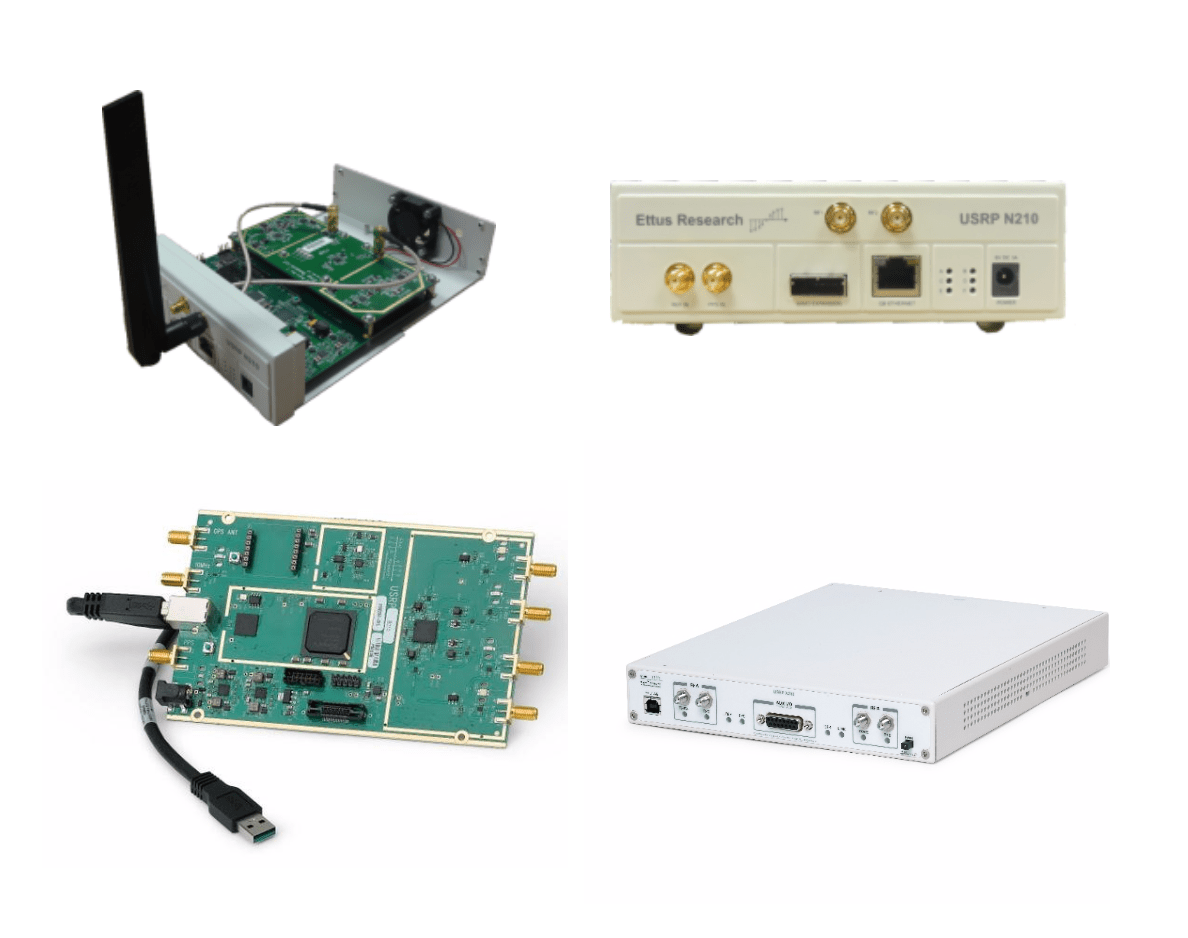
Figure 6: USRP N210 Device (upperside), USRP B210 Device and USRP X310 Device (lowerside)
RF Daughterboards
NITlab has equipped the USRPs with 2 different daughterboards, the XCVR2450 and the SBX which are the most appropriate for the multiple areas of the research taken place in NITOS testbed (802.11a/b/g/n, LTE, WiMAX, ZigBee). Descriptions for both daughterboards are stated below.

Figure 7: XCVR2450 2.4 GHz-2.5 GHz and SBX 400-4400 MHz Rx/Tx (N210 & X-Series)
| RF Daughterboards | ||
|---|---|---|
| XCVR2450 2.4 GHz-2.5 GHz | SBX 400-4400 MHz Rx/Tx (N210 & X-Series) | |
| The XCVR2450 is a high-performance transceiver intended for operation 2.4 GHz and 5.9 GHz range. Filtering on the XCVR2450 provides exceptional selectivity and dynamic range in the intended bands of operation. The typical power output of the XCVR2450 is 100 mW. Example applications include public safety, UNII, ISM, Japanese wireless and UWB development platforms. The XCVR2450 is a half-duplex transceiver. | The SBX is a wide bandwidth transceiver that provides up to 100 mW of output power, and a typical noise figure of 5 dB. The local oscillators for the receive and transmit chains operate independently, which allows dual-band operation. The SBX is MIMO capable and provides 40/120 MHz of bandwidth. The SBX is ideal for applications requiring access to a variety of bands in the 400 MHz-4400 MHz range. Example application areas include Wi-Fi, WiMax, S-band transceivers and 2.4 GHz ISM band transceivers. | |
The overall architecture of the NITOS facility is demonstrated in the following figure
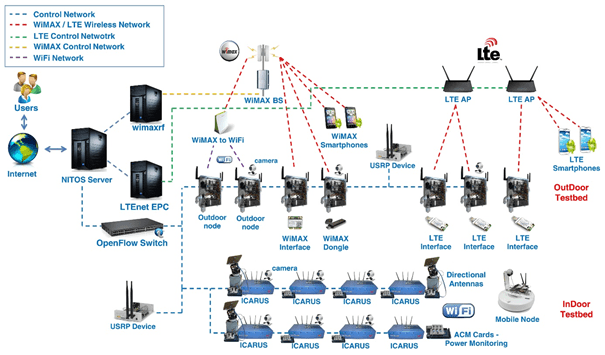
Figure 8: NITOS Facility Architecture
Experimentation
NITOS testbed is open to the research community 24/7 and it is remotely accessible through the NITOS reservation tool. Parallel experimentation of different users is enabled, through the utilization of the NITOS scheduler software. The testbed is based on open-source software that allows the design and implementation of new algorithms, enabling new functionalities on the existing hardware. Though OMF (cOntrol and Management Framework), NITOS supports the evaluation of protocols and applications under real-world settings.
5G Experimentation
NITOS offers OpenSourceMano (OSM) together with OpenStack to the experimenters ready to be provisioned and used with all the available testbed resources. Experimenters can use these tools to orchestrate the heterogeneous 5G infrastructure that NITOS offers.
Experiment examples
A vast amount of experiments can be performed including but not limited in the following areas:
- QoS mechanisms
- User Association mechanisms
- Dynamic frequency selection
- Rate adaptation mechanisms
- Video over wireless
- Routing
- Network coding
- Cooperative networks
- Video over wireless
- Sensor Networks
Contact
Filikis Etairias 78
Volos, 38334 – Greece
Email: nitlab@inf.uth.gr
Phone: +30 2421 306070
Fax: +30 2421 306065
More details can be found here: http://nitlab.inf.uth.gr/NITlab/




